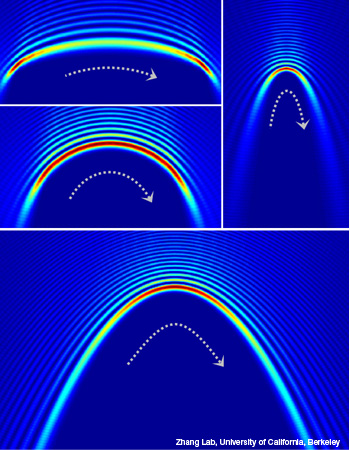
Simulations of Mathieu and Weber accelerating beams. Top left: Elliptical Mathieu beam with horizontal semi-major axis. Middle left: Circular Mathieu beam in the special case of equal semi-major and semi-minor axes. Right: Mathieu beam with vertical semi-major axis. Bottom: Parabolic Weber beam. White dotted arrows indicate direction of propagation.
For five years, scientists have studied Airy beams—a curious class of light beams that not only resist diffraction, but appear to bend in a parabolic arc as they propagate. An international team of researchers has found two new types of curving light beams that may lend themselves to nanotechnology applications (Phys. Rev. Lett. 109, 193901).
Airy beams work only in a narrow zone limited by the paraxial approximation, so they break or disperse too fast for some of the applications that the team envisioned, according to Peng Zhang, a postdoctoral researcher in OSA Fellow Xiang Zhang’s nanoscience group at the University of California at Berkeley (U.S.A.) and the lead author of the study. The newly discovered categories of beams are nonparaxial, so they not only bend to larger angles than Airy beams, but they are much more controllable for practical tasks.
One of the types of beams investigated by Zhang and his colleagues, called Mathieu accelerating beams, comes from solving the Helmholtz equation in elliptical coordinates. The nonparaxial circular accelerating beams that other groups have found recently represent a special case of the Mathieu beams. Likewise, Zhang’s team found that the Weber accelerating beams result from an exact solution of the Helmholtz equation in parabolic coordinates, and Airy beams are simply the paraxial approximation of Weber beams.
Zhang’s group studied the Mathieu and Weber beams experimentally as well as theoretically. To generate the beams, the researchers sent 532-nm laser light through a holographic mask, and they used a tank filled with a watery suspension of polystyrene nanoparticles to view the curving beams from the side.
Zhang and his colleagues would like to use the new beam types to guide microparticles and steer surface plasmon polaritons. They also want to try to curve the beam back on itself, creating an “optical boomerang” effect that is still purely theoretical.
Other researchers in the group are from the Institut National de la Recherche Scientifique (Canada), Nankai University (China), San Francisco State University (U.S.A.) and Lawrence Berkeley National Laboratory (U.S.A.).
